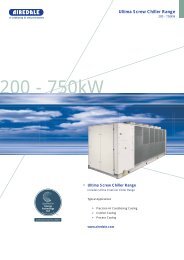Chillers ULTIMA COMPACT - Airedale International Air Conditioning
Chillers ULTIMA COMPACT - Airedale International Air Conditioning
Chillers ULTIMA COMPACT - Airedale International Air Conditioning
Create successful ePaper yourself
Turn your PDF publications into a flip-book with our unique Google optimized e-Paper software.
<strong>ULTIMA</strong> <strong>COMPACT</strong> <strong>Chillers</strong><br />
Installation Data<br />
WATER SYSTEM<br />
Component<br />
Recommended<br />
Requirements<br />
CAUTION<br />
Pump Statement<br />
Pressure Testing<br />
Filling<br />
CAUTION<br />
CAUTION<br />
The recommended requirements to allow commissioning to be carried out correctly are:<br />
• The inclusion of Binder Points adjacent to the flow and return connections, to allow<br />
temperature and pressure readings.<br />
• A flow switch or equivalent, fitted adjacent to the water outlet side of the Chiller.<br />
<strong>Chillers</strong><br />
18 Installation & Maintenance : 903-129 IM E 10/04/C<br />
The correct operation of the flow switch is critical if the chiller warranty is to<br />
be valid.<br />
• A 20 mesh strainer fitted prior to the evaporator inlet.<br />
• A water-flow commissioning valve set fitted to the system.<br />
• In multiple chiller installations, 1 commissioning valve set is required per chiller.<br />
• <strong>Air</strong> vents are to be installed at all high points and where air is likely to be trapped at<br />
intermediate points.<br />
• Drain points are to be installed at all low points in the system and in particular<br />
adjacent to the unit for maintenance to be carried out.<br />
• Isolating valves should be installed adjacent to all major items of equipment for ease<br />
of maintenance.<br />
• Balancing valves can be installed if required to aid correct system balancing.<br />
• All chilled water pipework must be insulated and vapour sealed to<br />
avoid condensation.<br />
• If several units are installed in parallel adjacent to each other, reverse return should<br />
be applied to avoid unnecessary balancing valves.<br />
When installing circulating water pumps or equipment containing them, the following rules<br />
should be applied:<br />
• Ensure the system is filled with water then vented and the pump primed with water<br />
before running the pump. This is required because the pumped liquid cools the pump<br />
bearings and mechanical seal faces.<br />
• To avoid cavitation the NPSH (Net Positive Suction Head) incorporating a safety<br />
margin of 0.5m head must be available at the pump inlet during operation.<br />
When all the pipework has been connected in the system, proceed as follows:<br />
• Ensure all shut off and control valves are fully open.<br />
• Pressurise system to the operating pressure, hold for 1 hour (a gradual fall in<br />
pressure shown on the gauge indicates a leak).<br />
• Leaks should be found and repaired and the unit pressure tested for a further hour.<br />
When the pressure remains at the operating pressure for 1 hour, the system can be<br />
considered leak free.<br />
Although a pressure of 1.5 x working pressure is adequate for testing purposes,<br />
most local water authorities require 2 x working pressure.<br />
The whole system MUST be flushed prior to filling to remove debris left in the<br />
water pipework by using a flushing bypass as shown to avoid serious damage to<br />
the plate evaporator.<br />
During filling the system should be vented at all high points.<br />
Once the system has been completely vented all vents should be closed.<br />
To prevent air locking in the system it is advisable to fill the systems from the lowest<br />
point, ie drain point on pipework.<br />
If auto air vents are used then we strongly recommend an auto pressurisation unit be<br />
fitted to the system.









